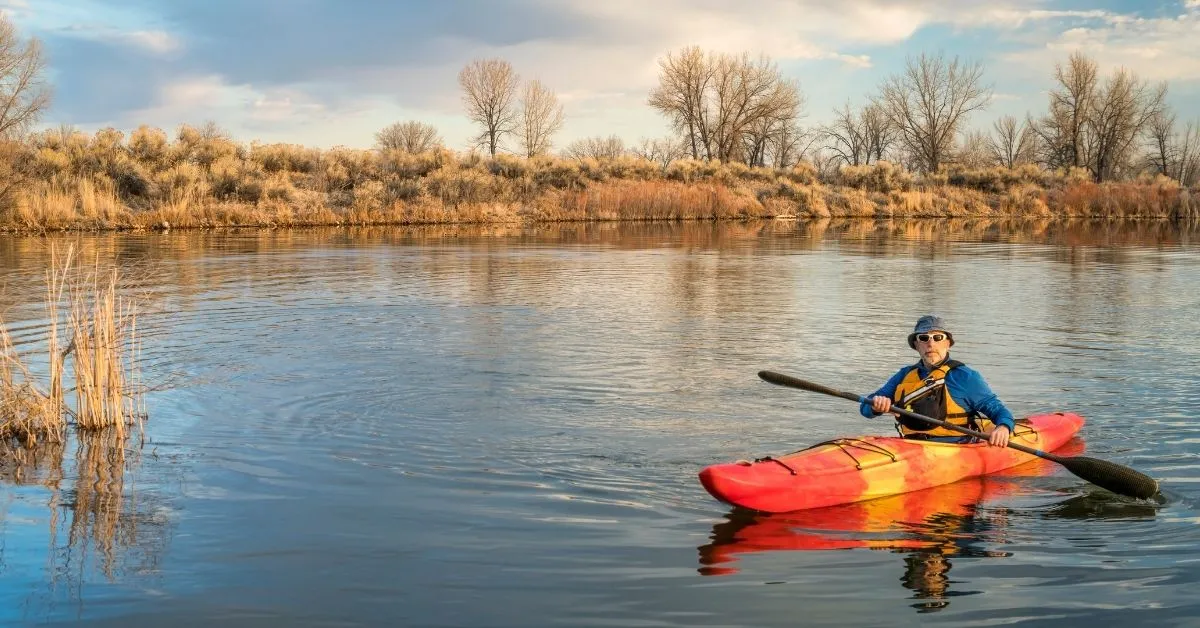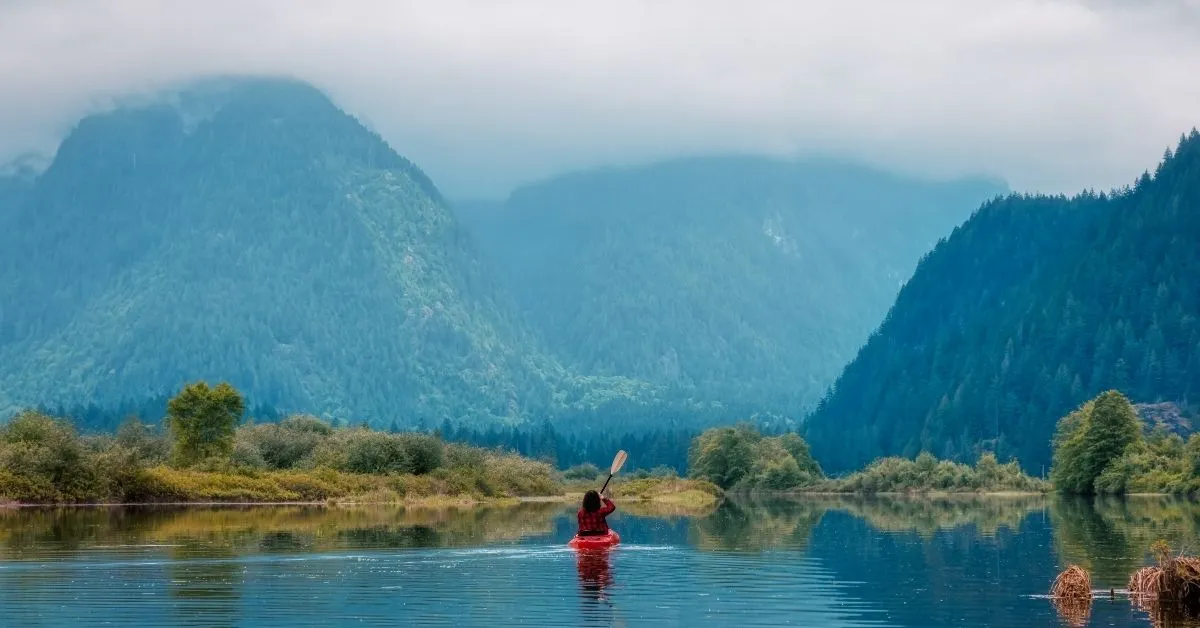With the arrival of spring comes the chance to get back onto the water and enjoy your favorite water sports again. While it’s still too cold for swimming, the mild air and increased sunshine hours make spring an ideal season for kayaking.
However, knowing what to wear for outdoor sports during the shoulder season can be confusing. What’s more, not wearing the proper clothing for watersports can significantly dampen your experience and enjoyment.
If you’re wondering what to wear kayaking in spring, read on. In this spring kayaking guide, we’ll share the best apparel that will keep you warm in the spring chills and protect you from both rainfall and the cold waters below.
How To Decide On What To Wear For Kayaking In Spring
As with hiking and other outdoor activities, layers are essential when kayaking during the shoulder season. Because there’s a high chance of getting wet, it’s best to wear multiple thin layers. This is because they will dry much quicker than one thick layer will.
It’s also essential that you don’t head out into your kayak in running or hiking gear. Watersports require specialized apparel, especially in colder weather. Here’s how you should dress for kayaking.
Psst. Wondering what to wear for kayaking during summer and hot weather? Read our complete guide to find out what to wear kayaking in summer.
Paddle top And bottoms
Paddle tops and bottoms often make the best clothes for kayaking in spring. They keep the elements out and can be worn with or without a wetsuit or thermals, making them a versatile item of apparel for all seasons.
Most paddle tops, also known as cags, feature waterproof and breathable material. The Yak Zeus Kayak Whitewater Cag also has neoprene cuffs and neck lining to keep out spray.
Likewise, paddle bottoms are made from neoprene or nylon with sealed waists and ankle cuffs to keep the water out. Some also have reinforced knees and bums. This prevents wear and tear from the frequent movement of getting in and out of the kayak.
If you don’t want to splash out on specialized apparel, you can wear some lightweight, quick-drying hiking pants instead, along with a long-sleeve rashguard.
Wetsuits
Although wetsuits are best suited to summer kayaking, it’s still worth considering one for the spring. At the beginning of the season, when it’s chilly, they can add an extra layer of warmth under your mid-layer.
Then, thanks to the concept of layering, if the temperature drastically increases throughout the day, you can remove your outer layers if needed.
Wetsuits are also essential for safety during low temperatures. Capsizing in cold water can result in shocks to your lungs and heart as well as hypothermia.
Thick neoprene wetsuits create insulation when you’re submerged in water. The intelligent material holds a thin layer of water heated by your body next to your skin so that the cold water does not cause shock to your system.
Wetsuits can be short-sleeved or long-sleeved and come with varying levels of thickness. A 5mm thick wetsuit, like the ZCCO Wetsuit, is sufficient for most climates and environments.
Thermals
If you worry about the cold, thermals are one of the best clothes for kayaking in spring. They will keep you warm even if the temperature drops or your clothes get wet.
Therefore, they are worth wearing pre-summer when the water is yet to warm up and the weather is unpredictable.
Like the MEETYOO Thermal Underwear Set, most thermals are made from moisture-wicking fabric like polyester that keeps your skin dry.
They make an excellent alternative base layer to a wetsuit for spring, as they offer more warmth while in your kayak and are cheaper, too.
Neoprene Socks
When kayaking in the summer, you can enjoy the warm breeze in between your toes as you kayak barefoot. However, if the wind is too chilly in the spring, you’ll need some footwear to keep you toasty.
A 3mm thick pair of Rtdep neoprene socks and waterproof shoes do the job perfectly, keeping the water out and the heat in.
Drysuits
Most beginners looking for what to wear kayaking in spring look at the cost of a drysuit and immediately dismiss it. Paddlesport drysuits, such as the VZKAK Drysuit, are highly rated but considerably expensive.
Although it’s nice to have a drysuit, it’s not essential for every kayaker. Drysuits are particularly beneficial to those who kayak in climates where the water stays cold for most of the year.
So, if the water only warms up from June and gets cold again in September, they can be worth the investment.
What’s more, if you kayak regularly, you’ll get your money’s worth. However, if you only go kayaking a few times a year, a drysuit is probably unnecessary.
Outer Layers
There are many cheaper alternatives to dry suits that work well as an outer layer for kayaking. If there is a significant chance of rain or strong winds, wear a lightweight rain jacket and rain pants with wind protection.
Alternatively, you could bring a fleece jacket if rain is not likely.
Other Considerations
- Material – Certain fabrics are more moisture-resistant and quick-drying than others. For example, cotton becomes very heavy when wet, dries slowly, and leaves you feeling cold and damp all day. On the other hand, neoprene and fleece quickly whip away moisture and retain your body heat even when wet.
- Comfort – As you’ll be sitting for long periods, you’ll need clothing that feels comfortable. Although you don’t want clothes that are too loose, they shouldn’t be tight either. Moreover, ensure they don’t cause any chafing or scratching.
- Durability – Your clothes will come in contact with water and the elements, so you’ll need rugged apparel that can handle more than normal wear and tear. Unique abrasion-resistant fabrics such as polyamide are robust, water-resistant, and withstand surface wear.
- Sun protection – Although it may not feel like it, the sun can still be hot enough to burn your skin during spring. We recommend choosing apparel with SPF protection to keep you protected on any unexpected hot days. What’s more, choosing spring clothing with UPF-rated fabrics allows you to continue wearing them into summer too.
Kayaking Spring Outfit Ideas
If you’re new to this watersport, getting all the gear can feel a little confusing and overwhelming.
So, to help you clearly understand what to wear kayaking in spring, here are spring outfit ideas for men and women.
Kayak Outfit Ideas For Men
Start your Spring kayaking outfit with the Thermajohn Men’s Ultra Soft Thermal Underwear. It’s lightweight and quick-drying, and the polyester material is soft, warm, and chaff-free.
For your mid-layer, opt for neoprene jacket and an adjustable velcro neoprene collar that gives the perfect balance of water protection and ventilation. It also has an elasticated drawcord at the waist and fully taped seams all over to maximize water protection.
Keep your feet warm with these Wetsuit Socks, made from 3 mm of neoprene fabric. They are anti-slip, so you can even wear them without shoes in your kayak, and they will protect your skin from sharp objects if you capsize.
Finally, take a waterproof or fleece jacket, depending on the weather conditions.
Kayak Outfit Ideas For Women
For your base layer, we recommend the Thermajane Women’s Ultra Soft Thermal Set, which comes in lightweight, mid-weight, or heavy-weight, so you can match it to your climate.
The Attaco Women’s Long Sleeve Rash Vest makes an excellent mid layer as it is quick-drying and protective. The lightweight fabric also has a 4-way stretch, so every movement feels comfy, and it boasts UPF 50+ sun protection, too.
The NRS Women’s Endurance Paddling Jacket is waterproof and breathable and has adjustable neck and wrist closures to keep you warm.
Pair this with some dry pants or simply opt for a dry suit for women.
Lastly, don’t forget to keep your toes warm and dry with a pair of water socks or shoes. Check out these practical and stylish XUKER Neoprene Socks 3mm. They will keep you dry if should you get wet.
Final Thoughts On Kayaking In Spring
The gorgeous blue skies and increase in temperature make spring a pleasant time for watersports. Even so, whether you’re kayaking in a river, lake, or the ocean, you’ll still need to protect yourself from the chilly water.
The kayaking clothes mentioned in this article will keep you warm and dry no matter the weather, allowing you to fully enjoy your peaceful surroundings.
Searching for gift ideas for the kayak lover in your life? Check out our list of kayak gifts.
Need help with clothing? Read one of the following blog posts:





